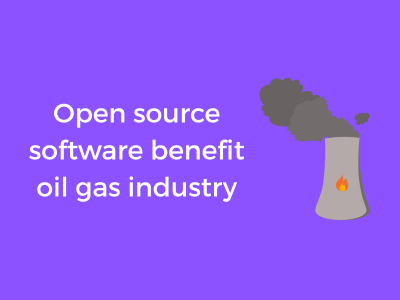Imagine the vast, complex process of oil and gas exploration and production where success relies on the seamless collaboration between geologists, engineers, data scientists, and project managers. Sounds challenging, right? This is where open source software steps in as a true game-changer! Let’s break it down and see how it builds a collaborative infrastructure that skyrockets operational efficiency.
Standardization for a Global Workforce
Oil and gas projects are global, often involving partners and stakeholders scattered across different regions. Proprietary tools often present challenges because they may not be universally adopted or supported. Open source platforms resolve these issues by offering widely accepted standards that make collaboration smoother. This standardization also reduces the learning curve for new team members or external partners, enabling faster onboarding and project alignment.
IOT in automotive industry benefits applications its future: Read More.
Empowering Cross-Disciplinary Teams
- Geoscientists: Using open source geospatial tools, geoscientists can share and overlay geological maps and stratigraphic data in real time, enhancing accuracy in locating oil reserves.
- Data Specialists: Advanced open source analytics software helps data scientists crunch numbers and create predictive models accessible to all stakeholders.
- Engineers: Teams can utilize platforms to co-develop simulations for pipeline flow and reservoir performance, ensuring optimal designs and strategies.
Version Control for Efficiency

Collaboration can quickly turn into chaos if version control isn’t managed correctly. Fortunately, open source tools often integrate with solutions like Git, enabling teams to track changes, comment on updates, and even roll back to previous versions if needed. This ensures that everyone is working off the latest and greatest version of the project plan or model—no more wild goose chases trying to find the right file!
Future-Proofing Collaboration with Community Support
Here’s another perk: open source solutions often come with a vibrant, global community of developers and users. These communities aren’t just there to answer complex coding questions—they frequently provide input based on industry-wide challenges. This makes open source tools particularly fluid and adaptable for the dynamic needs of industries like oil and gas.
Cost Efficiency and the Reduction of Licensing Expenses
Let’s face it—budget is always a big deal, especially in an industry as resource-intensive as oil and gas. But what if I told you open source software could be your financial superhero? That’s right! Open source software doesn’t just cut costs; it transforms the entire way you think about expenses related to technology. Let’s dive into the specifics and discover how.
1. Free from Traditional Licensing Fees
One of the most obvious benefits of open source software (OSS) is the elimination—or dramatic reduction—of software licensing expenses. Traditional, proprietary software often demands steep per-user or per-usage license fees, which can quickly inflate costs. Now imagine reallocating that budget toward other vital areas like research or upgrading on-site equipment. Sounds good, doesn’t it?
By opting for OSS, your company gets robust, industry-grade tools without those high upfront costs. Projects like OpenFOAM (used for CFD simulations) or **GeoPandas** (for geographic data analyses) offer powerful features at, you guessed it, zero cost!
2. Pay Only for What You Need
Here’s the beauty of OSS: you’re not trapped in a one-size-fits-all scenario. With proprietary software, you may end up paying for features or modules you’ll never use, just because they’re bundled into pricey packages. Open source flips that script: it’s modular, flexible, and endlessly customizable.
You have the freedom to tailor the software according to the specific processes or tasks your team needs most. Instead of shelling out for a bloated suite of tools, you can focus only on the essentials, and that means cost-efficient operations and no wasted resources.
3. Say Goodbye to Vendor Lock-In
Ever felt tied down by a vendor who has control over your software environment? It’s a common frustration when working with closed-source systems. Open source liberates you from this cycle. You can make independent decisions about updates or replacements without undergoing exhausting negotiations with a third-party vendor. Less dependency means you’re in control, with no surprise costs cropping up in the future!
4. Community Support Over Commercial Support
Some people worry about paying for customer support when switching to OSS, but here’s the twist: the worldwide developer community often steps in! Many open source projects boast vibrant communities filled with knowledgeable contributors happy to share tips, fixes, and enhancements. In many cases, this support is available for free through forums, web tutorials, or GitHub repositories.
If you require dedicated support, you’ll still come out ahead; hiring external experts or services for OSS is often significantly cheaper than securing proprietary software maintenance contracts.
5. Long-Term Sustainability Benefits
Let’s not forget the bigger picture here: the cost-efficiency of OSS isn’t just about immediate savings. Over the long run, the absence of perpetual licensing and software obsolescence makes it a sustainable choice. Reduced costs mean more room for innovation, and we all know how vital staying ahead of the curve is in this competitive industry.
Customizable Tools for Well and Reservoir Optimization
The oil and gas industry is no stranger to challenges; from extracting resources efficiently to ensuring reservoirs are optimized for long-term productivity, it’s often like solving a very complex puzzle. And here’s where open-source software shines—providing customizable tools tailored to the specific needs of well and reservoir optimization.
Why Customization Matters
Think of open-source software as a well-stocked DIY toolbox for your operations. Unlike off-the-shelf proprietary software—which often comes with rigid features and limitations—open-source solutions let users modify the code to match their unique operational requirements. For instance, a field with peculiar geological traits or unconventional resources might need software tools that analyze its data in specific ways. With open-source, you can tweak, modify, and experiment without waiting for a vendor to roll out updates.
Benefits of Customization for Well Performance
Optimizing oil wells is critical to ensuring consistent yields, and this is where customized software tools become a lifesaver. Let’s break it down:
- Adaptability to Complex Reservoir Traits: Open-source platforms give engineers the freedom to model reservoir behaviors—including those that are highly unpredictable. By tailoring algorithms, you can simulate complex flow dynamics and take more informed decisions.
- Enhanced Monitoring and Predictive Maintenance: Customized tools can prioritize early warning indicators—like pressure drops or temperature anomalies—helping teams prevent failures before they get expensive. This isn’t just smart; it’s a cost-effective lifesaver.
- Precision in Field Strategies: With the right customization, you can fine-tune recovery techniques, such as water flooding or gas injection, for maximum efficiency—without relying on generic workflows.
How Open-Source Tools Drive Reservoir Optimization
When it comes to reservoirs, optimization is the name of the game. Open-source solutions integrate everything from seismic data to production history, enabling teams to optimize hydrocarbon recovery rates. Here are a few standout elements:
- Scalable Simulations: With custom, open-source programs, you can run high-fidelity reservoir simulations, incorporating everything from rock porosity to fluid flow across varying pressure bands.
- Modular Designs: Many open-source solutions allow teams to stack specific modules—like water disposal planning or gas balancing—onto broader workflows. This saves time and allows better task focus.
- Real-time Adjustments: Need to adjust injection rates or optimize for unexpected water breakthroughs? Customizable tools give you the flexibility to reconfigure strategies on the fly, keeping operations resilient.
Accessible and Inclusive Development
One of the coolest parts about open-source software is that you’re never working alone. Tons of contributors within the open-source community continuously enhance these tools, allowing operators in the oil and gas industry to harness cutting-edge features without heavy R&D investments.
Plus, adaptability ensures that both large-scale operations and niche players can access scalable solutions. Got a small-cap company looking for comprehensive well solutions without breaking the bank? Open source has got your back.
Enhanced Data Sharing and Interoperability Among Teams
If there’s one thing the oil and gas industry thrives on, it’s teamwork. From geologists studying underground formations to engineers designing extraction methods, countless teams need to collaborate effectively to ensure everything operates like a well-oiled machine—pun intended! Open source software is proving to be a game-changer here, especially when it comes to enhanced data sharing and interoperability.
Breaking Down Silos with Open Standards
One of the biggest hurdles in the oil and gas sector has traditionally been data silos. Picture this: your geology team collects one set of data, the drilling team works on another, and the production crew focuses on something entirely different. Often, these datasets live in separate systems, making integration a logistical nightmare.
Open source software, built on open standards, is a hero in this story. These platforms foster seamless communication and integration between various tools, systems, and teams. Everyone can easily access and share relevant information without the headache of translation or compatibility issues. By ensuring that datasets can “speak the same language,” open source tools promote transparency and better collaboration across the board.
Real-Time Collaboration for Better Decision-Making
Imagine being able to view and analyze data in real-time across different teams working on the same project. That’s exactly what open source platforms enable. These tools empower teams to make decisions quicker, thanks to the ability to access up-to-date information simultaneously. When time is of the essence—say, in a drilling operation—this kind of efficiency can lead to substantial cost savings and improved safety.
This real-time collaboration doesn’t just stop at internal teams. Open source solutions also make sharing data with external stakeholders, like contractors or regulatory bodies, a breeze. By eliminating unnecessary bottlenecks in communication and ensuring everyone has the information they need, these platforms help projects move forward smoothly.
Interoperability: The Key to Unlocking Potential
So, what exactly is interoperability? Think of it as the ability for different systems and software to work together effortlessly. In an industry as technologically complex as oil and gas, where dozens of tools and platforms are in play, interoperability isn’t just a nice-to-have—it’s a must.
Open source software is naturally designed with interoperability in mind. Developers from around the globe contribute to creating tools that can easily plug and play with other systems. This eliminates the need for costly, time-consuming custom integrations and ensures that your tech ecosystem evolves as your needs grow.
Tips for Making the Most of Open Source Data Sharing
Here are a few practical steps to enhance data sharing and interoperability in your organization:
- Invest in training: Ensure your teams are well-versed in using the open source tools available to them.
- Standardize data formats: Adopt open standards to reduce issues when sharing or converting data between systems.
- Encourage community involvement: Have your developers participate in open source communities to stay ahead of trends and updates.
- Prioritize cybersecurity: Although open source is generally secure, keep your data protected with robust security practices.
Security Measures Enhancing Operational Reliability
Let’s talk about something that’s on everyone’s mind: security. In an industry as critical as oil and gas, protecting operational systems and valuable data isn’t just a nice-to-have—it’s an absolute must. Security measures in open-source software are not about plugging gaps after the fact; instead, they’re about preparing and creating strong defenses to enhance operational reliability right from the start. Let’s explore how open-source plays a game-changing role in this area.
1. Transparency Breeds Trust
One of the biggest advantages of open-source software is its transparent nature. The code is open for anyone to scrutinize, inspect, and improve. This means that vulnerabilities don’t stay hidden for long. Instead of relying on proprietary software companies to identify and fix bugs, an entire global community of developers can work together to identify risks quickly and patch them effectively.
Think about it: It’s like having a neighborhood watch program for your software. Everyone’s keeping an eye out, which makes it much harder for cybercriminals to linger undetected.
2. Built-In Resilience for Operations
In the oil and gas industry, reliable operations are everything. Downtime can lead to huge losses—and in some cases, safety risks. Open-source tools often come with features designed to improve system reliability, such as robust logging, automated recovery from failures, and redundancy mechanisms.
By consistently fine-tuning these security-focused measures in their code, open-source developers create software solutions designed to withstand the unique challenges of complex oil and gas operations—from offshore rigs to high-pressure drilling environments.
3. Community-Driven Security Audits
If you rely only on internal audits from proprietary software providers, you’re limited by the scope of their work. However, open-source software benefits from large-scale community-driven security audits. Experts from different fields, regions, and industries comb through the code to identify and mitigate potential security threats.
This collective intelligence ensures your systems are protected by the best minds in tech. Plus, open-source software often undergoes rigorous external evaluations, meaning you’re not taking the word of a single vendor. The oil and gas industry’s growing reliance on open source can therefore foster a sense of collective vigilance across the digital ecosystem.
4. Frequent Updates to Combat Evolving Threats
Cyber threats are constantly evolving, and that means your defense strategies need to evolve, too. Open-source software is dynamic and updated frequently to adapt to emerging threats. While proprietary tools may wait for a single company to roll out updates (often on their timeline), open-source platforms allow teams to patch or upgrade software as soon as vulnerabilities are discovered.
For oil and gas companies, this rapid reaction capability is critical. It means they can minimize vulnerability windows and reduce the potential for disruptions caused by malware, ransomware, or other types of cyberattacks.
5. Tailored Solutions for Specific Security Needs
Every oil and gas operation is different. Open-source platforms allow security solutions to be customized entirely in-house or in collaboration with developers. This is particularly valuable for dealing with specific industry challenges, such as secure communications between offshore rigs, centralized data hubs, and operational command centers.
Accelerated Innovation Through Community-Driven Development
Let’s take a moment to dive into one of the most exciting aspects of open-source software in the oil and gas industry: community-driven development. Community-driven development is like the brainchild of collaboration and innovation, but what does it actually mean for oil and gas? Pull up a chair, and let me explain why it’s such a game-changer!
The Power of Collective Genius
At its core, community-driven development allows a global network of developers, engineers, and domain experts to work together to create and refine software. Think of it as tapping into the collective brainpower of the best and brightest minds across the globe. Unlike proprietary software, which relies on a limited team of developers, open-source projects leverage the collective knowledge and creativity of an enthusiastic community.
Now, for the oil and gas industry, this means faster solutions. When there’s an issue or a need for a new tool, you don’t have to wait for a single software company to roll out an update. Instead, you benefit from the input, feedback, and fixes contributed by hundreds (or even thousands) of skilled individuals. Massive teamwork on a global scale? Yes, please!
Speeding Innovation and Solving Challenges
Innovation in oil and gas often hinges on complex data analysis, advanced algorithms, and customizable solutions for things like seismic modeling or production forecasting. Open-source software thrives in these areas because it allows experts from all corners of the industry to not only create but improve tools at lightning speed.
- Want a custom feature? The community might already be working on it, or you can collaborate to develop it.
- Encounter a software bug? Chances are, it’s fixed fast because dozens of others might encounter and resolve the same issue.
- Need novel approaches? The open-source world often encourages out-of-the-box thinking, which can generate groundbreaking solutions to longstanding challenges.
This “just-in-time” innovation keeps the industry nimble, allowing businesses to adapt to changing technologies and market demands with confidence.
Driving Down Barriers to Entry
One often-overlooked but very cool aspect of community-driven development is how it democratizes software development. Smaller oil and gas companies can get involved too! In a proprietary system, they might have been priced out due to high costs or lacked the technical team to develop custom solutions in-house. But in open source? Everyone is welcomed into the proverbial coding circle. This creates a more level playing field, propelling innovation across the board—not just for the giants of the industry.
Fostering a Culture of Collaboration
Beyond the technical aspects, the open-source community fosters a culture of collaboration and trust. Experts share their know-how and experiences freely, often building meaningful networks across domains. This spirit of cooperation encourages industry progress in a way that proprietary software just can’t replicate. After all, the best ideas are rarely born in a vacuum—they thrive in communities.
Environmental and Regulatory Impact Monitoring
Let’s talk about something we all care about – our environment! When it comes to the oil and gas industry, keeping track of environmental and regulatory impacts is not just a choice – it’s a responsibility. Luckily, open source software is stepping up as a hero in this essential area.
Here’s the thing: monitoring environmental impact can be a complex juggle of data, rules, and constantly evolving regulations. Have you ever considered how open source software can simplify all of that? I’ll explain how.
Tracking Emissions with Precision
One big environmental focus in oil and gas is emissions tracking. Whether it’s greenhouse gases or other pollutants, you need to measure, analyze, and track this data regularly. With open source software, you’re looking at a cost-effective way to implement smart tools tailored to your operation’s unique needs.
Many open source tools boast advanced algorithms that can crunch data in real-time, helping you identify patterns and anomalies faster. Plus, because the code is transparent and modifiable, engineers and environmental teams can customize these tools to meet site-specific conditions, ensuring that no environmental factor slips through the cracks.
Adaptability to Changing Regulations
If there’s one constant in the oil and gas industry, it’s that regulations evolve. Governments worldwide frequently refresh policies to address pressing climate and safety concerns. Trying to keep up with it all can be daunting, right?
Open source software shines here because it is community-developed. Other experts and professionals from across industries contribute updates to stay aligned with the latest rules, ensuring compliance is baked into the software. This means that your team can focus on other priorities while staying confident that you’re operating within legal frameworks.

Empowering Transparency and Accountability
Imagine being able to present your company’s environmental data to stakeholders, regulatory bodies, or even the public with full transparency. Tools based on open source platforms make it easier to log and report everything from water usage and habitat impacts to waste management strategies.
Since the software is highly modifiable, it can be designed to include specific reporting formats, making compliance reporting not only straightforward but also credible. Trust me, this kind of transparency can strengthen your company’s reputation in leaps and bounds.
Community Collaboration for Sustainability
Here’s the fun part about open source software – you’re not alone! Developers, environmental scientists, and industry experts actively collaborate to make tools smarter and more efficient. You can share your feedback and contribute ideas, creating solutions that genuinely drive sustainability.
This type of collaboration accelerates innovation and allows for quicker problem-solving, particularly when addressing environmental challenges that are unique to oil and gas operations.
Not convinced yet? Let me sum it up for you:
- Cost savings: Forget hefty licensing fees for environmental monitoring tools.
- Real-time adaptability: Stay on top of shifting regulatory landscapes without headaches.
- Shared expertise: Tap into a global community focused on environmental preservation.











